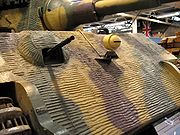
Zimmerit
Encyclopedia
.jpg)


World War II
World War II, or the Second World War , was a global conflict lasting from 1939 to 1945, involving most of the world's nations—including all of the great powers—eventually forming two opposing military alliances: the Allies and the Axis...
for the purpose of combating magnetically attached anti-tank mine
Anti-tank mine
An anti-tank mine, , is a type of land mine designed to damage or destroy vehicles including tanks and armored fighting vehicles....
s, although Germany was the only country to use magnetic mines against tanks in large scale numbers. It was created by the German company Chemische Werke Zimmer AG.
Operation
The coating was a barrier that prevented the direct contact of magnetic mines against the metal surfaces of the vehicle. It was normally ridged to increase the overall thickness. This spacing reduces magnetic attraction, and causes magnetic mines to fall off from their own weight and the vibration of the vehicle. Zimmerit possessed no anti-magnetic properties of its own, rather it defeated the mines by disallowing contact and providing distance.Deployment
Zimmerit was applied to some tanks and closed-top self-propelled guns produced from December 1943 to 9 September 1944. It was only rarely applied to open-top AFVs. The rough appearance of the coating gave a distinct appearance to the vehicles it coated.Application of Zimmerit was usually done at the factory. The many variations seen in application designs, from the regular ridge-shaped pattern, to a less common waffle-shaped pattern, are mostly related to the factory producing each type of AFV. For example, the waffle pattern was seen almost exclusively on Sturmgeschütz III
Sturmgeschütz III
The Sturmgeschütz III assault gun was Germany's most produced armoured fighting vehicle during World War II. It was built on the chassis of the proven Panzer III tank...
assault guns. In general, vehicles already in service were not given coats of Zimmerit.
Zimmerit was discontinued from factory application on 9 September 1944 and from field application on 7 October 1944. This was due to concerns that projectile impacts could set it on fire. These proved false, but the order was never rescinded. Applying and drying the paste added days to the production of each vehicle, which was unacceptable as there was a shortage of tanks.
Following the war, the British carried out trials of a similar material on Churchill tanks but decided not to implement it. No similar material was used on post-war tanks, probably because the widespread use of man-portable HEAT
Heat
In physics and thermodynamics, heat is energy transferred from one body, region, or thermodynamic system to another due to thermal contact or thermal radiation when the systems are at different temperatures. It is often described as one of the fundamental processes of energy transfer between...
rockets such as the Bazooka
Bazooka
Bazooka is the common name for a man-portable recoilless rocket antitank weapon, widely fielded by the U.S. Army. Also referred to as the "Stovepipe", the innovative bazooka was amongst the first-generation of rocket propelled anti-tank weapons used in infantry combat...
made magnetic mines obsolete.
Ingredients
The paste was composed of the following:- 40 % Barium sulfateBarium sulfateBarium sulfate is the inorganic compound with the chemical formula BaSO4. It is a white crystalline solid that is odorless and insoluble in water. It occurs as the mineral barite, which is the main commercial source of barium and materials prepared from it...
- BaSO4 - 25 % polyvinyl acetatePolyvinyl acetatePolyvinyl acetate, PVA, PVAc, poly, is a rubbery synthetic polymer with the formula n. It belongs to the polyvinyl esters family with the general formula -[RCOOCHCH2]-...
– PVA (similar to wood glueWood glueWood glue is an adhesive used to tightly bond pieces of wood together. Many substances have been used as glues.-Types of wood glue:* For many centuries animal glue, especially hide glue was the traditional glue for all kinds of woodwork. It is still used today, mainly for musical instruments and...
) - 15 % pigmentPigmentA pigment is a material that changes the color of reflected or transmitted light as the result of wavelength-selective absorption. This physical process differs from fluorescence, phosphorescence, and other forms of luminescence, in which a material emits light.Many materials selectively absorb...
(ochreOchreOchre is the term for both a golden-yellow or light yellow brown color and for a form of earth pigment which produces the color. The pigment can also be used to create a reddish tint known as "red ochre". The more rarely used terms "purple ochre" and "brown ochre" also exist for variant hues...
) - 10 % Zinc sulfideZinc sulfideZinc sulfide is a inorganic compound with the formula ZnS. ZnS is the main form of zinc in nature, where it mainly occurs as the mineral sphalerite...
– ZnS - 10 % sawdustSawdustSawdust is a by-product of cutting lumber with a saw, composed of fine particles of wood. It can present a hazard in manufacturing industries, especially in terms of its flammability....

